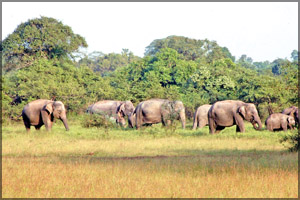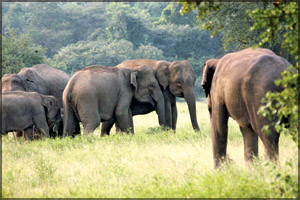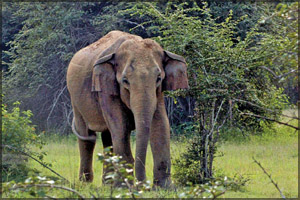Positive steps towards elephant conservation in Sri Lanka
Simple solutions for Jumbo problems:
Jayantha Jayewardene
CONFLICT: Recently the President directed the Minister of Natural
Resources to get his ministry to concentrate, as a priority, on sand
mining, garbage disposal and human elephant conflicts. In any event
these were the areas that the Minster was going to focus on anyway.
It is extremely prudent for the minister to focus on a few very
important and pressing problems and
|

Herds of elephants are made up of related females and their
young, which could be from five to 10 animals |
attempt to solve them rather than
trying to solve all problems and probably not achieve much.
The conservation of a species necessitates the provision of all
resources (habitat, security, food, water etc) necessary to maintain a
stable population into the long-term future.
Conservation has two aspects; one is the protection of the species
and the other, scientific management of the species and the resources
necessary for its conservation. The continued existence of the Asian
elephant in the wild is threatened not only by the actions of some but
also due to others not taking any action.
Two months ago the minister had a meeting with many of those
concerned with and interested in elephant conservation. It was to a
great extent a very fruitful meeting in that the present situation with
regard to elephant conservation in general and human elephant conflicts
in particular were discussed in detail.
With the new minister there is a great possibly that elephant
conservation in Sri Lanka will take a new direction which will be
positive towards the conservation of the elephants in the wild. However,
from a pragmatic point of view, we must realise and accept the fact that
every wild elephant in this country cannot be saved.
The Department of Wildlife Conservation made a presentation of the
work that they had hitherto done. More importantly Dr. Prithiviraj
Fernando made a presentation of the results of the research on wild
elephants that he and his team had carried out for the past eight years
in the southern part of the island.
The results of the research conducted by Dr. Fernando are very
important in that they disprove some of the perceptions that our
conservation activities have been based on for a long time. For instance
his findings with regard to elephant corridors and home ranges are
different to what we had assumed earlier.
|

Adult males form loose associations among themselves forming
‘male groups’ especially when raiding crops |
I will deal with this in more detail later. In his presentation he
also gave us new options that we could use as strategies for our
elephant conservation planning and activities in the future. The
Minister, at this meeting, stressed that it was a priority of the
Ministry and the Department of Wildlife Conservation to carry out pilot
projects to test the new strategies. This, I think, is a positive start.
One of the major setbacks to the conservation of the Asian elephant,
in all its range states, is the fact that almost in all cases the
governments of those countries have to play a major proactive role and
give leadership to the efforts that are being made by conservationists.
Most governments do not have the conservation of elephants as one of
their priorities. Sri Lanka is an exception in that elephant
conservation is regarded as one of the highest priorities by the
government as well as the non-governmental conservation establishment in
the country.
However, the non-availability of actual data on which to base
management plans, has been a major drawback in Sri Lanka as well as the
rest of the range. Consequently, management actions have been based on
outdated beliefs handed down from colonial times.
One need of the hour is to activate the IUCN Asian Elephant
Specialist Group or to consider the formation of a body comprising
representatives of all the Asian range states, together with those
experienced and knowledgeable on the Asian elephant, coming in from all
over the world.
This organisation has to be very dynamic and give Asian elephant
conservation a lead and a new direction. It
|

In Sri Lanka elephants have distinct home ranges of about 50-150
square kilometres to which they show a very high level of
attachment |
has to necessarily deal with
governments if the conservation programs are to be effective. It has to
look at the scientific management and research needs of each country, prioritise them, seek sufficient funding and ensure the proper
implementation of each project. A great effort by many from many places
is necessary to ensure the continuance of the Asian elephant in the
wilds.
There was an extensive elephant research project carried out by the
Smithsonian Institution in the 1960s. This research program, which was
led by eminent foreign scientists such as George McKay and John
Eisenberg brought Sri Lanka into the forefront of elephant research.
However, with the ending of the Smithsonian program the scientists
returned to their countries and there was no continuation of the work by
Sri Lankan scientists. Since then for a long period there was no
significant research on wild elephants in this country, with a few
sporadic exceptions such as the work by Ishwaran.
While the following decades saw massive development and changes in
the country that had immense impacts on elephants, Sri Lanka's elephant
conservation and management remained mired in traditional approaches
that had no scientific basis.
The team led by Dr. Prithiviraj Fernando and consisting of Dr. Devaka
Weerakoon, Manori Gunawardene, Dr. Eric Wikremanayake, H.K. Janaka and
L.K.A. Jayasinghe have carried out research on various aspects of
elephant behaviour - their biology, ecology, ranging patterns and the
human-elephant conflicts that are prevalent.
Their research done over the past one and a half decades has been
mainly concentrated in the south of Sri
|

Adult males are solitary and join a herd only for a short time
to mate |
Lanka and also in the North
Western Province. Their research findings have been significant but
unfortunately the Department of Wildlife Conservation has been slow in
adopting these newfound results in their elephant management and
conservation strategies.
Some of the new facts that are now available to elephant managers and
conservationists are:
1. Herds of elephants are made up of related females and their young,
which could be from five to 10 animals or even going up to 20 to 25 in
number. Adult males are solitary and join a herd only for a short time
to mate. They may also form loose associations among themselves forming
'male groups' especially when raiding crops.
2. Even though it was thought earlier that elephants migrate long
distances seasonally, this does not happen in Sri Lanka. Instead, they
have distinct home ranges of about 50-150 square kilometres to which
they show a very high level of attachment.
3. Management is necessary if the elephants are causing problems or
if they have a problem. Most problems for people are caused by males. In
many cases actions such as elephant drives and electric fencing used in
attempts to mitigate such problems are ineffective against the males.
However, the herds suffer from these actions. Therefore, elephant
management needs to be conducted based on monitoring the impacts
management activities have on elephants as well as the effectiveness of
such actions in mitigating the problem.
Herds have home ranges that are fixed. They never go outside their
home ranges. Some home ranges are big and others are small. The size of
a home range depends on the rainfall and the size of the herd. The
higher the rainfall the smaller the home range.
If there is less rainfall then the home ranges are extended. This is
because the rainfall, to a great extent, determines the availability of
food. A home range is a function of habitat quality - better the habitat
the smaller the home range. Not only do elephants stick to their home
ranges but they use the same routes and paths in their seasonal
movements, within the home range, each year or season.
4. Till recently the practice has been to drive elephants into
national parks such as Yala and Lunugamvehera and surround them with an
electric fence so that they cannot escape and raid crops. However now it
is confirmed that home ranges of over two thirds of the elephants lie
outside protected areas.
We also know that national parks are not zoos. Animals must be free
to move in and out according to their requirements of food, water, etc.
As a result of trapping too many elephants in Yala and Lunugamvehera
many animals, particularly females and young, have died of starvation
and malnourishment. It is not uncommon now to see elephants walking
around in Yala looking like skeletons.
Our national parks should not become ghettos for animals. We should
not try to brush the problem into the parks. We need to find ways and
means of having elephants live within human-modified landscapes, such as
shifting agriculture areas, since it has been shown that such landscapes
provide the optimal habitat for elephants. elephants.
To make this a reality, we have to devise ways of benefiting people
who share habitat with elephants, who currently derive zero benefit from
elephants but bear a heavy burden.
5. Obviously it is na‹ve to say we have to stop development and allow
elephants to be in all jungle habitats.
However, what has been happening is that when the jungle habitats of
the elephants are taken up for development purposes, major elephant
drives have been undertaken which drive elephants from areas to be
developed as well as from extensive areas of state land that is not to
be developed, and where elephants could remain for the future. The
Lunugamvehera drive conducted in 2006 is a prime example of this.
Although the development area was only a little more than a 100
square kilometres, elephants were driven away from over 500 square
kilometres of state land. When development takes place it is not
necessary to drive the herds of elephants, living there, as was done
during the Accelerated Mahaweli Program and more recently from
Suriyawewa to Lunugamvehera.
A close evaluation of these activities over time has shown that the
herds of elephants will move away with advancing development activities,
leaving only the lone males behind. Such lone males are the ones that
create problems and cannot be driven any way, therefore will have to be
dealt with on a case-by-case basis.
It is very easy to criticise what others, including what the
Department of Wildlife Conservation is trying to do in terms of elephant
conservation, especially if you have not tried to do much yourself.
However the need of the hour is for all concerned to get together and
make a concerted and cooperative effort to save our elephants for their
long-term future.
Otherwise, as is happening now, whilst we are criticising, bickering
and fighting elephants in the wild are dying by the day.
What we must strive to achieve, in our efforts at elephant
conservation, is to make quite sure that our populations of wild
elephants will continue in adequate numbers, in different locations, and
are in a position to reproduce the numbers that would ensure their
conservation into the future.
(The writer is Managing Trustee, Biodiversity & Elephant Conservation
Trust) |

